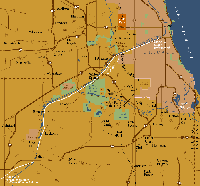 |
 |
|
|
|
The need for
an all-water trade route became obvious after
Jefferson's Louisiana Purchase in 1803. The promise of
great lands was confirmed by the reports brought back by
Lewis and Clark in 1806, leading to a flood of migration
to the west. An additional water route was required, and
Congress commissioned a study for a canal to replace the
portage. In 1818, Illinois was admitted to statehood. At
that time the northern border of the state, originally
intended to be near the south tip of Lake Michigan, was
moved many miles north so that the entire potential route
of the canal would be in a single jurisdiction.29 |
The report to Congress in
183330 is full of enthusiasm (and hyperbole); "There
is not, perhaps, on the face of the globe, a place where
such a mighty physical revolution could be produced with
so little human labor."31 An Illinois and Michigan
Canal was proposed, at an estimated cost of $4,299,43932,
which later grew to a construction cost of $6.5 million. |
 |
| Route of Illinois and Michigan Canal and the Chicago Sanitary and Ship Canal. |
The I
& M Canal, as designed, was to run from the Chicago
River at Bridgeport southwest over the continental divide
and then parallel to the Des Plaines River, finally
meeting the Illinois River at La Salle Peru, where the
Illinois River became fully navigable. The total length
was to be ninety-six miles. The general dimensions of the
waterway were to be sixty feet wide by six feet deep. The
locks were to be one hundred ten
feet long by eighteen feet wide33. There were to be fifteen
locks to accommodate the one hundred fifty foot drop34 from
Bridgeport to La Salle. There were aqueducts to allow the
canal to pass over the Fox River and over smaller
streams. Locks allowed water-level crossing of other
rivers.To feed the canal and operate the locks, water
was to be supplied from many of the rivers and streams
along the route. Water was also to be pumped into the
canal from the Chicago River, which induced a slight flow
out of Lake Michigan in dry weather.35
|
| |
< Previous
Page
|
Next Page >
|




